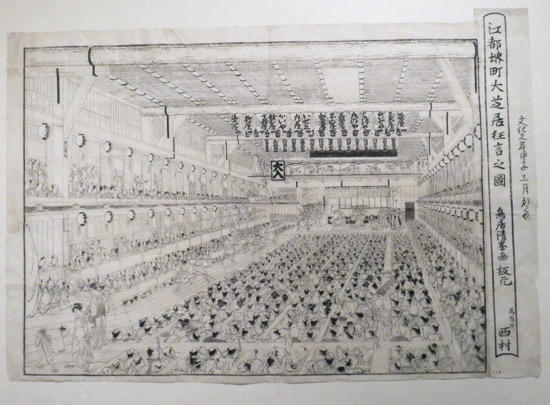 |
| A view in the centre of the new gallery |
It has also of course made a major contribution to the way Japanese Art influenced art and design in Europe during the late 19th century and onwards.
Toshiba Gallery of Japanese Art
The Toshiba Gallery of Japanese Art (Room 45) reopens at the V&A Museum in London tomorrow.It's undergone a "refresh" of the content on display and how it is displayed. The project has represented a major collaboration of different teams within the V&A from curation to the display teams and those involved with technical lighting and signage.
I visited the preview yesterday and you can see images of the new exhibition in this post.
The Gallery of Japanese Art - sponsored by Toshiba - at the V&A is one of my favourite galleries. I always visit it whenever I visit the museum. Some of the objects feel like old friends!
It's also FREE TO ENTER! The Japanese Gallery is open daily 10:00 - 17.45 and until 22:00 on Fridays
 |
| Japanese Inro in the Japanese Gallery at the V&A |
The V&A's collection of Japanese lacquerware contains around 2,500 pieces, of which 800 are lacquered inro (small, highly decorated containers that were worn suspended from the sash).The Gallery has been closed in order to bring it up to the standards of exhibition space and display that the Museum now aspires to.
- The original cases remain in place.
- However the interior displays and the lighting and signage have all been changed.
- Plus there are 400 new objects are on display of which some 30 are recent acquisitions. There are two major new displays relating to the developing of Japanese design in the 20th and 21st centuries - covering modern and contemporary objects such as interior design, product design, electronics, photography, graphics and fashion - and it now includes items from Muji and to 'Hello Kitty'.
- Much of the ceramics collection is now displayed within the revamped Ceramics Gallery - on the 6th floor - (Rooms 136 – 146. Room 137 houses the ceramincs which relate to Asia) This is an article about the Ceramics Galleries: Old and New
There are three entrances to the gallery and hence its layout is themed and linked with no particular recommended route.
The new exhibition has a pleasing way of reminding you that one of the purposes of museums like the V&A is to influence and inspire those who are designing the decorative arts today.
Thus some of the displays mix very old pieces with pieces from the 20th or 21st centuries.
 |
| In the display relating to the Tea ceremony it's very difficult to determine which are the pieces made centuries ago and which were made in the last 10 years. |
 |
| Two were made between 1700 and 1800 and one was made in 2004 - but which is which? |
Two examples below illustrate the nature of some of the items on display at either end of the timeline.
 |
| Tea Bowl (tenmoku) - earthenware with a silver rim (dated 1150-1250) on top of a Bowl Stand (dated 1600-1800) - comprising carved black, red and ochre lacquer. |
 |
| Heel less shoes by Noritaka Tatihana (dated 2014) handcrafted from leather, metal and wood - they reference the towering shoes worn by the courtesans of the Edo period - the shoemaker makes shoes for Lady Gaga. His heel-less shoes were originally made for his graduation project in 2010 |
 |
| 20th century kimonos are displayed next to Dress Accessories dating back centuries |
Graphic Art
I'm particularly pleased to see not only prints but books of prints in a central case within the room. To my mind this one aspect of the previous gallery which has been remedied. I could never understand how little was given over to the artwork which played a really significant part in the development of European art in the late 19th century.Both the stand alone prints and the images in books have a lot to teach those who draw today in terms of reportage and narrative scenes of commonplace activities of the everyday - and some of the more specialised activities of those who are not quite the same as everybody else!
I'd certainly recommend anybody interesting in Japanese prints and Japonisme to pay this gallery a visit.
 |
| Books containing Japanese Prints |
 |
| Japanese Prints of Courtesans of the Edo Period |
 |
| A perspective drawing of the interior of a Kabuli Theatre (1804) ink on paper |
To make it easier for teachers and lecturers to access the most popular material with groups, we have developed themed study room resources which contain original prints and drawings. This study room resource explores the art of ukiyo-e Japanese prints including the works of Utamaro, Hokusai, Hiroshige and Kuniyoshi.Those keen to draw in the V&A should note that photography and sketching are permitted throughout most of the Museum (except in the Temporary Exhibition spaces). For more information visit Access and Photography of V&A Collections and Exhibitions
Sponsorship
The sponsorship by Toshiba of this gallery is apparently one of the first examples of corporate sponsorship. They have sponsored the Gallery continuously since the Gallery was created and opened on 17th December 1986. when it was opened by Princess Alexandra.
More Articles
- The Guardian - V&A brings Japanese craftsmanship back to life for gallery reopening
- Forbes - Hello Kitty And Cute Kawii Street Fashion In Japan's New Toshiba Gallery At The V&A
- Idun Gallery - Toshiba Gallery - From Renovation to Innovation
No comments:
Post a Comment
COMMENTS HAVE BEEN CLOSED AGAIN because of too much spam.
My blog posts are always posted to my Making A Mark Facebook Page and you can comment there if you wish.
Note: only a member of this blog may post a comment.